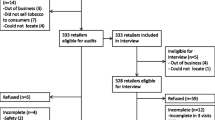Abstract
The objective of the study was to augment important findings from a 1996 statewide survey of Indiana pharmacists regarding their opinions and practices related to the sale of cigarettes and alcohol in pharmacies. More specifically, this study was designed (1) to determine opinions and practices of Kentucky pharmacists' related to the sale of cigarettes and alcohol; (2) compare these findings with results from the Indiana study; and (3) to gather information on health promotion activities by Kentucky pharmacists. A structured survey questionnaire was designed and reviewed by a jury of experts and subsequently administered to half of the 1182 pharmacies in Kentucky. Collected data were analyzed by using descriptive and inferential statistical methods. Findings reveal that 45 percent of responding pharmacists sell cigarettes in their stores even though 88 percent think that their stores should not sell cigarettes. Approximately 34 percent of the pharmacies in non-dry counties sell alcoholic beverages while more than four-fifths of the pharmacists (81%) think pharmacies should not sell alcoholic beverages. After adjusting by type of pharmacy, no statistical difference was found in retail-chain pharmacy sales of cigarettes and alcohol in either Kentucky or Indiana. However, independent pharmacies in Kentucky were less likely to sell cigarettes and alcohol compared to independent Indiana pharmacies. Study results also revealed that most pharmacists agree the use of cigarettes and alcohol are important causes of morbidity and pre-mature mortality and that pharmacists should play a role in health promotion and disease prevention through their relationship with the public. However, the majority do not ask their patients about their smoking and alcohol habits and do not participate in health education/promotion programs for the general community.
Similar content being viewed by others
REFERENCES
De Young, M. Research on the effects of pharmacist-patient communication in institutions and ambulatory care site, 1969-1994. Am J Health Syst Pharm 1996;53:1277-1291.
Phelan, M.J. & Jepson, M.H. The advisory role of the general practice pharmacist. Pharmaceut. J. 1980;223:584.
Molzon, J.A. What kinds of patient counseling are required? Am Pharm 1992;NS32:50-57.
American Pharmaceutical Association. Pharmacist Practice Activity Classification 1.0. [On-line] 1998. Available:http://aphanet.org/AphA/practiceclass.html.
American Association of Colleges of Pharmacy. Educational Outcomes. Alexandria, Virginia, 1994.
Carl, T. & Trinca, J. The pharmacists' progress toward implementing pharmaceutical care. J of Amer Pharm 1995;March:10-15.
Maguire, T. Is the community pharmacist a health educator? Pharm J. 1990;245:556-559.
O'Loughlin, J., Masson, P., Dery, V. & Fagnan, D. The role of community pharmacists in health education and disease prevention: A survey of their interests and needs in relation to cardiovascular disease. Prev Med 1999;28:324-331.
Scott, D.M. & Wessels, M.J. Impact of OBRA '90 on pharmacists' patient counseling practices. J Am Pharm Assoc 1997;NS37:401-406.
Kotecki, J.E., Elanjian, S.I., Torabi, M.R., & Clark, J.K. Pharmacists' concerns and suggestions related to the sale of tobacco and alcohol in phamacies. J Comm Hlth 1998;23:359-370.
Centers for Disease Control and Prevention. Chronic diseases and their risk factors: The nation's leading causes of death. [On-line] 1999. National Center for Chronic Disease Prevention and Health Promotion. Available:http://www.cdc.gov/nccdphp.
U.S. Department of Health and Human Services. Healthy People 2010 (conference edition, in two volumes). Washington, DC: January 2000.
Drug Interactions & Updates Quarterly. Applied Therapeutics, Inc. Lea & Febiger, 1995.
Rumore, M.M. Pharmacy and tobacco. Ann Pharmacother 1997;31:1253-1256.
Kotecki, J.E., Torabi, M.R., & Elanjian, S.I. Pharmacists' opinions and practices related to the sale of cigarettes and alcohol-a follow-up study. J Comm Hlth 1997;22:469-479.
Smith, M.D., McGhan, W.F., Lauger, G. Pharmacist counseling and outcomes of smoking cessation. Am Pharm 1995;NS35:20-29.
Orleans, C.T., Resch, N., Noll, E. Keintz, M.K., Rimer, B.K., Brown, T.V., & Snedden, T.M. Use of transdermal nicotine in a state-level prescription plan for the elderly. A first look at ‘real-world’ patch users. JAMA, 1994;271:601-607.
Smith, F.J., Salkind, M.R., & Jolly, B.C. Community pharmacy: A method of assessing quality of care. Soc Sci Med 1990;31:603-607.
Weber, M.P., Reed, M.T., & Kroner, S.E. Health promotion and disease prevention: the pharmacist's role. Am Pharm 1989;NS29:37-39.
Kotecki, J.E., Elanjian, S.I., & Torabi, M.R. (in press). Health promotion beliefs and practices among pharmacists. J Amer Pharm Assoc.
Author information
Authors and Affiliations
Rights and permissions
About this article
Cite this article
Kotecki, J.E., Fowler, J.B., German, T.C. et al. Kentucky Pharmacists' Opinions and Practices Related to the Sale of Cigarettes and Alcohol in Pharmacies. Journal of Community Health 25, 343–355 (2000). https://doi.org/10.1023/A:1005168528085
Issue Date:
DOI: https://doi.org/10.1023/A:1005168528085




